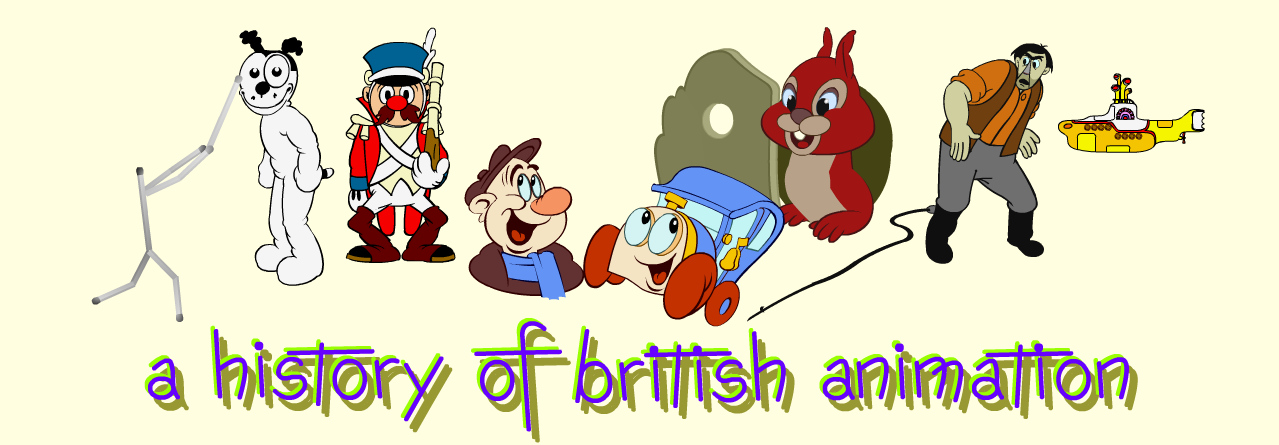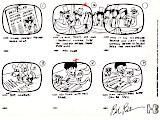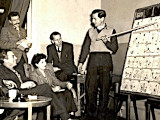

|
 | The Storyboard |  |
||
|
The term 'storyboard' refers to a sequence of pictures, usually with dialogue and other information included, that sets out the action for each scene of an animated film. (A further explanation is needed here. In live-action films a 'scene' is a sequence of shots that takes place in the same location, or is otherwise complete in itself. But in animation each individual shot is referred to as a 'scene', and a complete set of 'scenes' constitutes a 'sequence'.) Historically 'storyboard' refers to a specific method of story presentation adopted at Disney's, and credited to storyman Webb Smith. The New York animators in the silent era were often given a segment of a film and left to develop the action for themselves, with just a vague story arc and a given set of characters to guide them. But in California, Disney was more concerned with crafting his films. By the time he started producing the Oswald the Lucky Rabbit cartoons, in 1927, he had an organized production system. In order to complete a film every two weeks he had two animation teams, one led by Ub Iwerks and Friz Freleng and the other by Hugh Harmon and 'Ham' Hamilton. Walt canvassed all the studio staff for plot and gag ideas, for which he paid bonuses. A story would then be thrashed out between Disney and the relevant unit heads. Once the agreed film script was typed up, the lead animators would sit down and draw up the continuity sketches on sheets of paper divided into 6 panels a page, showing the principle action per shot, and numbered as per the written description of the action. These would be carefully drawn to show layout and background details as well as character proportions, action and timing. After these had been approved by Walt, and any amendments made, the scenes would be assigned to the animators, who referred to copies of these sketches. This practice continued into the sound era. Animators' gag contributions would usually consist of drawings, which were pinned up on a display board for discussion during the story meeting. Other drawings could be scribbled up and added during the session. Some of the artists were more prolific in producing ideas than they were at producing quality animation, and Walt decided to move them into a permanent story department. Here they would draw up a lot of their ideas as story continuities to pin up on the board. Webb Smith's innovation was to present an entire film idea as individual continuity panels that could be re-positioned, removed or replaced as the meeting progressed. Walt saw the advantages of this, and the 'storyboard' was born – an actual display board with the story pinned to it. Continuity was expanded from one drawing per scene to panels showing the main points of action throughout the shot. (These were the 'key' poses for the scene, which animators would draw up first. The term 'keys' has since become interchangeable with the term 'extremes' – the first and last animation drawings of an action passed to an inbetweener to complete the sequence.) After the story had been thrashed out and changes made to the storyboard panels, the finalised board went to the director, who might make further changes while timing out the scenes. The storyboard could then be photostatted and copies given to the animators. When Disney moved into feature animation the storyboard panels were filmed to provide a further guide as to how the film would appear. (The panels were filmed individually on a filmstrip that was shown on a Leica still projector which had an electronic device that could move to the next frame when triggered by small breaks made in the soundtrack reel. When the marked soundtrack was run the projector would show the frames in syncronicity. This was called the 'Leica reel'.) The term 'storyboard' has since come to mean any depiction of a sequence in picture form. The practice of storyboarding was picked up by live-action filmmakers to help plan complicated sequences. It is usual for animated films to be fully storyboarded as this acts as a blueprint for the film, but the process of editing the individual panels during story meetings is usually only done on feature cartoons – episodes of TV series are frequently drawn up straight off from a written script with little or no need for changes. |
Peter Hale
Last updated 2025
|